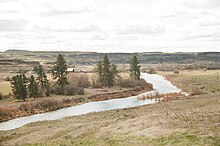Columbia Plateau Trail
The Columbia Plateau Trail is a 130-mile-long (210 km), 20-foot-wide (6.1 m) corridor in eastern Washington state along the abandoned right-of-way of the former Spokane, Portland and Seattle Railway. It runs between Cheney, Washington and Pasco at the confluence of the Snake River and Columbia River. It passes through parts of five counties in southeastern Washington. It is open to public for recreational use as part of the Washington State Park system. Uses include wildlife viewing, hiking, mountain bicycling, horseback riding and, in paved portions, in-line skating.[1][2]
Wildlife


The northern portion of the trail passes through the primarily ponderosa pine/grassland mixed with exposed basalt cliffs and areas of meadow and shrub-steppe. It bisects the Turnbull National Wildlife Refuge, an area of northeastern Washington on the eastern edge of the Columbia River Basin which encompasses approximately 16,000 acres (6,500 ha) of the channeled scablands.[3] The numerous erosion-created potholes have formed over 130 marshes, wetlands and lakes which attract a wide range of waterfowl; more than 200 different kinds of birds have been recorded in this area. The Turnbull National Wildlife Refuge was established in 1937 to provide productive breeding and nesting grounds for migratory birds. Other wildlife which inhabit the reserve include elk, mule deer, white-tailed deer, coyotes, badgers, porcupines, muskrats, and beavers.[4]
Geological features

As it crosses the Columbia River Plateau, the trail passes through the unique geological erosion features of the channeled scablands created by the cataclysmic Missoula Floods that swept periodically across this portion of eastern Washington as well as other parts of the Columbia River Plateau during the Pleistocene epoch. The trail follows one of the many paths taken by the Missoula Floods as they cut through the Columbia River Basalt. Notable geologic features which the trail passes include the Cow Creek scabland, the point at which the Palouse River departs its former course (captured by ice-age flood erosion), Washtucna Coulee (the abandoned course of the Palouse River scoured wide by the floods), Devil’s Canyon (a dry, straight, 4-mile-long (6.4 km) former flood channel which descends to the Snake River), giant current-created ripples formed by the flood currents in the low lands along the Snake River, and the Walker Bar, created by the outflow of the floods.[5]
Access points

Proceeding from the northeast toward the southwest, major access points include:
- Fishlake trailhead – Milepost 365
- Cheney Trailhead – Milepost 361.25
- Amber Lake Trailhead – Milestone 349.25
- Martin Road Trailhead – Milestone 342
- Lamont Trailhead
- John Wayne Pioneer Trail intersection (no trailhead)
- Benge Trailhead
- Washtucna Trailhead (Trail Administrative Area in downtown Washtucna)
- Kahlotus Trailhead & Visitor Center 46°38′41.77″N 118°33′17.67″W / 46.6449361°N 118.5549083°W
- Snake River Junction Trailhead
- Ice Harbor Dam Trailhead 46°14′58″N 118°52′46″W / 46.24944°N 118.87944°W
- Sacajawea State Park Pasco
References
- ^ "Columbia Plateau Trail State Park". Washington State Parks and Recreation Commission. Retrieved February 10, 2015.
- ^ "Columbia Plateau Trail Management Plan". Washington State Parks and Recreation Commission. 2006. Retrieved February 10, 2015.
- ^ "Turnbull National Wildlife Refuge". U.S. Fish and Wildlife Service. Retrieved February 10, 2015.
- ^ "Turnbull National Wildlife Refuge". U.S. Fish and Wildlife Service. Retrieved February 10, 2015.
- ^ Bjornstad, Bruce (2006). On the Trail of the Ice Age Floods: A Geological Guide to the Mid-Columbia Basin. Keokee Books; Sand Point, Idaho. ISBN 978-1-879628-27-4.
External links
- Columbia Plateau Trail State Park Washington State Parks and Recreation Commission
- Columbia Plateau Trail State Park North Map Washington State Parks and Recreation Commission
- Columbia Plateau Trail State Park South Map Washington State Parks and Recreation Commission
- Protected areas of Adams County, Washington
- Protected areas of Franklin County, Washington
- Protected areas of Lincoln County, Washington
- Protected areas of Spokane County, Washington
- Protected areas of Whitman County, Washington
- State parks of Washington (state)
- Hiking trails in Washington (state)
- Rail trails in Washington (state)

